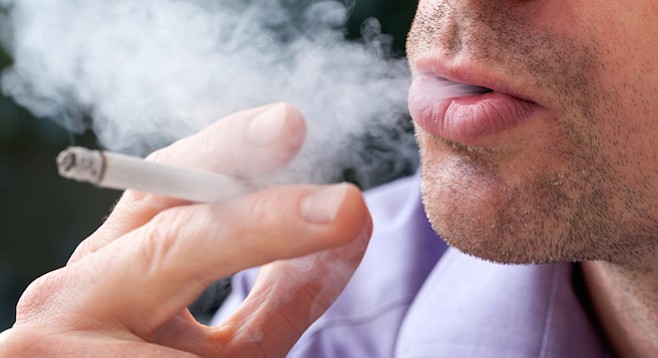 Facebook
Facebook
 X
X
 Instagram
Instagram
 TikTok
TikTok
 Youtube
Youtube

While the public has long been aware of the dangers of smoking and passive exposure to secondhand smoke, researchers at San Diego State University are raising a call for vigilance regarding the perils posed by thirdhand smoke, or residues left on surfaces that may not have been exposed to cigarettes in some time.
"Homes become reservoirs of tobacco smoke pollutants," says SDSU psychologist Georg Matt in a recent university press release. "These volatile compounds soak into the drywall; gypsum is like a bottomless pit for these toxins. Carpets are tremendous reservoirs."
Matt became interested in thirdhand smoke years ago, when he found certain byproducts of cigarettes in the children of participants in a smoking-cessation study, even though the parents no longer smoked or allowed others to do so near their kids. He's joined by environmental health scientist Penelope Quintana and environmental chemist Eunha Hoh in research that seeks a determination to what extent contamination from past smoking can affect current inhabitants of a closed space.
"Cigarette smoke is known to contain thousands of chemicals, and these chemicals get deposited onto surfaces," says Hoh. "The levels of these chemicals may be quite low in thirdhand smoke residue, but they are dangerous when you have chronic exposure."
Researchers warn that vacuuming carpets and dusting walls isn't enough to rid a home of contaminants from smoke. Even painting walls, they fear, may not be sufficient.
In order to safeguard children against the hazards of third-hand smoke, Matt recommends avoiding smoking indoors or in cars, staying in a smoke-free hotel rather than in the home of smokers when on out-of-town visits, requesting smokers wash their hands or, preferably, change their clothes before interaction, and avoiding buying or renting housing where the previous occupants may have smoked. Although e-cigarettes, an increasingly-popular tobacco alternative, do not emit many of the known carcinogens in cigarette smoke, they still contain nicotine and thus Matt recommends the same precautions be taken around users of such devices.
The group plans to study up to 200 low-income homes over the next three years in an attempt to learn more about affordable and effective means of eradicating existing smoke damage within residences.


While the public has long been aware of the dangers of smoking and passive exposure to secondhand smoke, researchers at San Diego State University are raising a call for vigilance regarding the perils posed by thirdhand smoke, or residues left on surfaces that may not have been exposed to cigarettes in some time.
"Homes become reservoirs of tobacco smoke pollutants," says SDSU psychologist Georg Matt in a recent university press release. "These volatile compounds soak into the drywall; gypsum is like a bottomless pit for these toxins. Carpets are tremendous reservoirs."
Matt became interested in thirdhand smoke years ago, when he found certain byproducts of cigarettes in the children of participants in a smoking-cessation study, even though the parents no longer smoked or allowed others to do so near their kids. He's joined by environmental health scientist Penelope Quintana and environmental chemist Eunha Hoh in research that seeks a determination to what extent contamination from past smoking can affect current inhabitants of a closed space.
"Cigarette smoke is known to contain thousands of chemicals, and these chemicals get deposited onto surfaces," says Hoh. "The levels of these chemicals may be quite low in thirdhand smoke residue, but they are dangerous when you have chronic exposure."
Researchers warn that vacuuming carpets and dusting walls isn't enough to rid a home of contaminants from smoke. Even painting walls, they fear, may not be sufficient.
In order to safeguard children against the hazards of third-hand smoke, Matt recommends avoiding smoking indoors or in cars, staying in a smoke-free hotel rather than in the home of smokers when on out-of-town visits, requesting smokers wash their hands or, preferably, change their clothes before interaction, and avoiding buying or renting housing where the previous occupants may have smoked. Although e-cigarettes, an increasingly-popular tobacco alternative, do not emit many of the known carcinogens in cigarette smoke, they still contain nicotine and thus Matt recommends the same precautions be taken around users of such devices.
The group plans to study up to 200 low-income homes over the next three years in an attempt to learn more about affordable and effective means of eradicating existing smoke damage within residences.
Comments